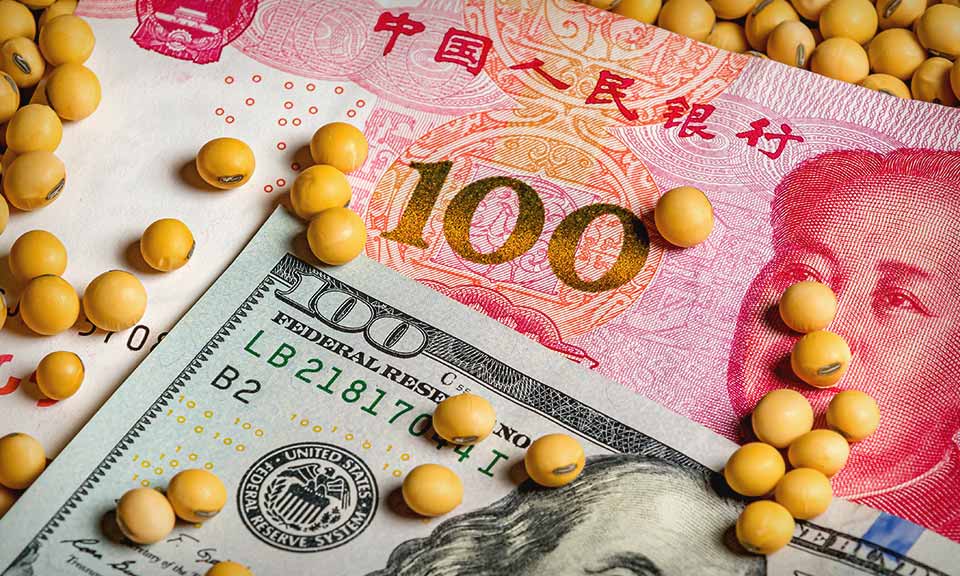Soybean meal prices in China hit record high amid tight supply

Soybean meal spot prices in China hit its highest level at Yuan 5,500/mt on average Sept. 26, up by 8% week on week, amid lower availability in the domestic market, sources said.
As CFR China soybean prices surged to a record high in March 2022, the Chinese crushers lowered the purchase volumes of imported soybeans for June shipment and onwards to minimize losses from deteriorating negative crush margins. Soybean meal prices were last higher at Yuan 5,150/mt on March 22.
According to industry sources, the demand for June to August 2022 shipments were only at 20 million mt, down by about 10% compared to same period last year. Subsequently, the arrival volume of imported soybeans during the third quarter of 2022 has dropped. The total import volume of soybeans in July and August 2022 was at 15.04 million mt, down by 5.6% compared to same period last year. As a result, many crushing plants have started experiencing shortage in soybeans this month, leading to lower crushing volume and declining soybean meal inventories.
Meanwhile, as the long holiday for National Day Celebration in China approaches, demands for hog prices continue to support hog raising margin which was at Yuan 800/mt last week. Downstream feed sectors are willing to purchase more soybean meal for feed usage and stockpiling during festival seasons. As a result, the growing demand has pushed prices higher during the recent weeks.
"It was heard that the spot soybean meal price has surged to Yuan 6,100/mt in Xinjiang Province, and spot prices remain at high levels in north-east regions of China," a Chinese crusher said.
The replacement crush margin was around Yuan 450/mt as of Sept. 23, up 50% compared to two weeks ago, market sources said.
"The replacement crush margin would remain positive as soybean meal prices will be supported until November when the arrival volume of imported soybeans is expected to increase as crushers have purchased higher volumes of soybeans for September shipment and onwards," a Chinese trader said.
However, buyers are concerned about the depreciation of Chinese yuan against the US dollar. "The depreciation of Chinese yuan has eroded potential gains on the crush margin, discouraging crushers to purchase more for spot shipment," another Chinese crusher said.

News
Bayer AG has announced the pilot of an expert generative AI (GenAI) system that “quickly and accurately” answers questions related to agronomy, farm management and Bayer agricultural products. The pilot has been developed in collaboration with Microsoft as leading technology partner and Ernst & Young (EY) as an industry partner, the company said. The system is the result of Bayer using proprietary agronomic data to train a large language model (LLM) with years of internal data, insights from thousands of trials within its vast testing network and centuries of aggregated experience from Bayer agronomists around the world, the company said. “Our unique GenAI system has the potential to serve agronomists and benefit farmers all over the world, further advancing AI as an indispensable technology for agriculture,” said Amanda McClerren, CIO and head of digital transformation & information technology for Bayer’s crop science division. Bayer said it is exploring ways to integrate the expert GenAI system into its digital offerings, and the company anticipates broad opportunities for collaboration with other agricultural offerings and partners. “Bayer aims to expand the pilot of the expert GenAI system to selected agronomists and potentially farmers as early as this year, while continuing to advance a separate GenAI prototype allowing users to directly query their own farm data,” the company said. In addition, the partnership between Bayer and Microsoft enables the company to bring ready-made capabilities, AgPowered Services, to the agri-food industry, such as Bayer’s Historical Weather that brings a comprehensive weather dataset to Azure Data Manager for Agriculture that spans the last 40 years and provides detailed, field-level weather insights across global agricultural regions, the company said. Integrating tools from IBM, including from the IBM Environmental Intelligence Suite, the new capability, which was previously available for internal use only, can inform weather risk assessments and actuary processes, Bayer said. It will also be used by Bayer and others to forecast crop seasonality and production changes year over year, as well as train agronomic models, it said. Meanwhile, Bayer is developing a connector that enables access to irrigation data from Lindsay Corp., an industry-leading irrigation solution provider. This expands the data types available to Azure Data Manager's enterprise customers, making it possible for them to connect to irrigation data in the same way as weather, imagery, original equipment manufacturer (OEM) and other data types, the company said. The new cloud offerings will also support regulatory and sustainability reporting, such as providing supply chain traceability that can help ensure compliance with new laws such as the EU Deforestation Regulation, which is expected to go into effect at the end of 2024, Bayer said. This article was first published in chemweek.com. Photo credit: Bayer

News
Asia has seen the fastest growth in biofuels production and exports globally, driven by government policies and export markets for feedstocks. To capitalize on the boom, governments have rapidly pushed out biofuel mandates focused around their country’s main agricultural products. Presently, the largest biofuel producers in the region are China, India, Indonesia, Malaysia, the Philippines and Thailand. Here’s a ready reckoner for Asia’s major biofuel policies along with production, trade and prices. Click for the full-size infographic